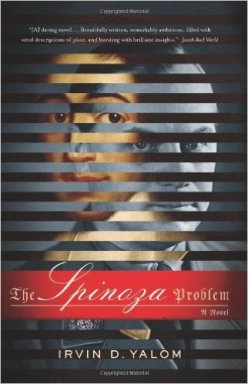 This book has much to commend it, despite the ending which I found disappointing.
This book has much to commend it, despite the ending which I found disappointing.
As I read the book I was thinking of giving it a five star rating, and the phrase that kept coming into my head was “a very satisfying read”. I had initially purchased the book on the strength of having previously read Yalom’s psychotherapy books, and another of his novels (which has what must be the most unattractive title for many readers – When Nietszche Wept). That novel, and his professional books, convinced me that the author could write very accessible prose on potentially challenging subjects, and that he was able to create characters with real psychological depth.
This book was satisfying on so many levels. It was written after the author was inspired by a visit to the Spinoza museum in Rijnsburg where he learned that Alfred Rosenberg (the intellectual force behind much of the Nazi anti-semitism) had deliberately and personally stolen the library of the Jewish philosopher. On one level, it was a book about two very different influential figures separated by three hundred years. It was interesting to learn about seventeenth century Jewish life in Amsterdam, and about Hitler’s rise to power in Germany. However, two factors gave the writing much more significance and impact.
First, by the use of fictional characters and conversations, Yalom gives his protagonists valuable psychological depth as they struggle to overcome the painful factors in their lives. Spinoza has to cope with the trauma of being excommunicated for life from his Jewish community in Amsterdam. He is tricked and betrayed and never allowed to speak to anyone in the community (including his brother and sister) again. Rosenberg is shown to be an inadequate figure who is shunned by his peers and who is constantly seeking recognition – especially from Hitler.
Second, by using extracts from their writing and from contemporary accounts (as well as from fictional conversations) Yalom, the great communicator and teacher, succeeds in explaining to the reader the bones of Spinoza’s philosophy which went on to impact the Enlightenment and great figures in German culture, and Rosenberg’s anti-semitism which was promoted by the Nazis to such disastrous effect. Given that both writers were not renowned for producing immediately accessible prose, this was no mean feat.
So. Why only four stars? I just felt let down at the end. Throughout the book the two lives had run side by side, but we felt that the two were linked because of what Rosenberg perceived as the Spinzoa problem. How could a Jew write such great philosophy that the anti-semite Rosenberg agreed with? For the reader, this linked the two lives as the book progressed. How was Rosenberg going to find a way of explaining the apparent contradiction so that he could accommodate his admiration? The problem was the title of the book. I wanted to know the answer.
Unfortunately there isn’t an answer. Rosenberg was unable to read Spinoza’s work in their original language once he had stolen the books, the events of the war took over, and we are never given a resolution. The whole book is created around two very interesting characters, interesting philosophical views, and are linked by an interesting problem which doesn’t have a resolution.
